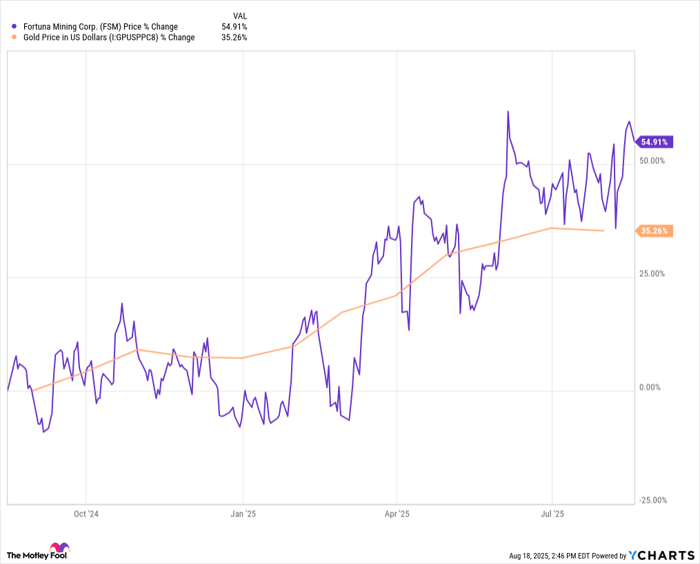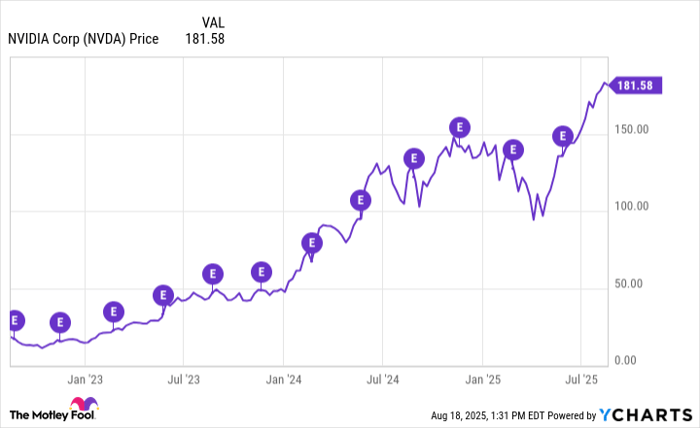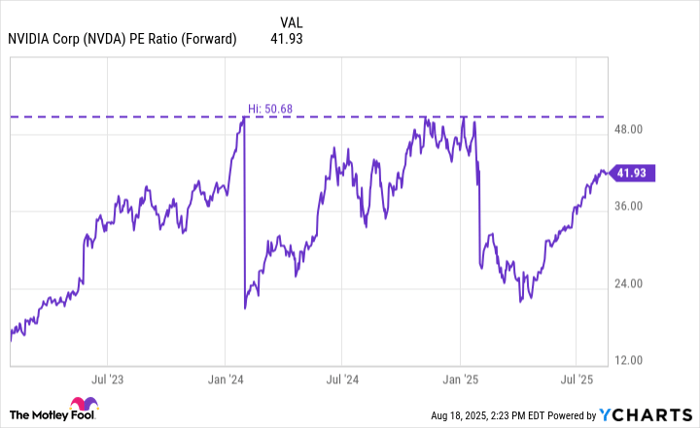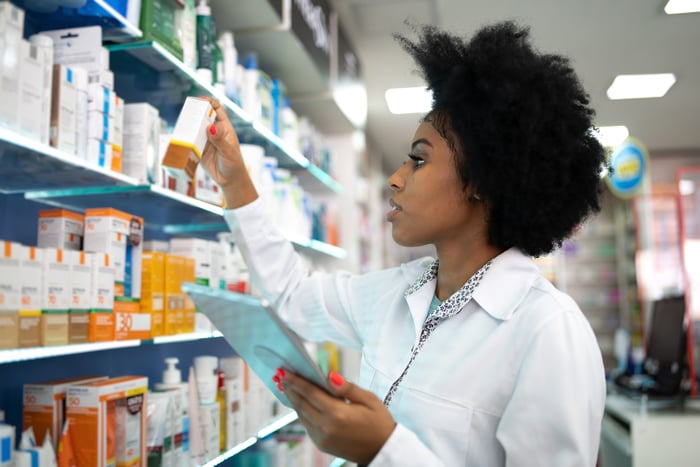
Image source: The Motley Fool.
Date
Aug. 18, 2025 at 5 p.m. ET
Call participants
Chief Executive Officer — Thiago Maffra
Chief Financial Officer — Victor Mansur
Operator
Need a quote from a Motley Fool analyst? Email [email protected]
Risks
Thiago Maffra explicitly stated, "2025 has demonstrated to be more challenging than we estimated, demanding more efforts from all our teams to keep growing our business in a profitable way," signaling a difficult operating environment affecting growth initiatives.
CFO Victor Mansur noted, "If the banks that give credit to their clients keep asking for investments in terms of reciprocity, we may suffer a bit more in Q3 and Q4 2025 since we are not going into this business," highlighting risk of continued corporate net outflows.
"Bear in mind, that we can have a change in tax rules which can impact currently tax-exempt fixed income instruments," Maffra stated, flagging regulatory uncertainty that may influence product demand and capital market activity.
Takeaways
Total client assets (AUM + AUA)-- BRL 1.9 trillion as of the latest quarter, representing 17% year-over-year growth.
Gross revenues-- BRL 4.7 billion, up 4% year-over-year and 2% sequentially in Q2 2025.
Retail revenue contribution-- 77% of total gross revenues came from the retail business in Q2 2025.
Net income-- BRL 1.3 billion, up 18% year-over-year and marking the highest quarterly figure in company history for Q2 2025.
Return on equity (ROE)-- 24.4% for the quarter, expanding 223 basis points year-over-year.
Capital ratio (BIS)-- 20.1%, up 110 basis points quarter-over-quarter in Q2 2025.
Active clients-- 4.7 million as of the latest quarter, up 2% year-over-year.
Diluted earnings per share (EPS)-- Diluted EPS grew 22% year-over-year in Q2 2025, outpacing net income growth due to share buyback execution.
SG&A expenses-- BRL 1.6 billion in Q2 2025, up 10% year-over-year and sequentially, mainly due to higher marketing and technology investments.
Efficiency ratio-- Improved to 34.5% for the last twelve months, a 161 basis point improvement versus the prior year.
Retail net new money-- Positive inflows in retail were offset by a $6 billion outflow in the corporate and institutional segments in Q2 2025, due to tighter liquidity and increased reciprocity requirements from banks for credit lines.
Retail credit card TPV-- Credit card volume grew 8% year-over-year in Q2 2025; affluent and private banking card offerings were launched.
Life insurance written premiums-- 45% year-over-year growth as of the latest quarter, with management highlighting early-stage potential.
Retirement plan client assets-- BRL 86 billion, up 15% year-over-year in Q2 2025.
New retail product revenues (FX, global investments, digital account, consortium)-- $256 million, up 146% year-over-year in Q2 2025, with consortium gaining traction from a zero base.
Issue services revenue-- Down 30% year-over-year and 5% quarter-over-quarter in Q2 2025 versus the all-time high in Q2 2024, due to softer DCM activity.
Corporate revenues-- Up 14% year-over-year and stable quarter-over-quarter, buoyed by derivatives solutions in Q2 2025.
Fee-based model penetration-- 5% of total client assets as of Q2 2025, with potential for gradual growth toward 7%-8% in the coming years.
Share buyback program-- BRL 1 billion buyback program to be executed through next year, with a target for total capital returns above 50% of net income for 2025 and 2026.
Summary
XP(NASDAQ:XP) delivered record net income (GAAP) and expanded profitability in Q2 2025, achieving significant increases in retail-driven revenues and asset growth despite a challenging macroeconomic environment and headwinds in the corporate and institutional segments. Management reaffirmed its 10% top-line growth target for this year, supported by new products, channel diversification, and ongoing expansion of sales teams, while warning of potential volatility from upcoming tax policy changes and continued pressure on corporate net new money. Shareholder returns remain a top priority through both elevated capital ratios and a defined buyback, even as SG&A increases outpaced revenue growth due to marketing and technology outlays.
Maffra said, "we are convinced that we have a more sustainable revenue model and profitability is a consequence," highlighting management's confidence in the business model's adaptability.
Mansur noted, "the EPS growth pace was again faster than our net income growth" in Q2 2025, directly linking share buybacks to EPS expansion.
Management outlined that while fee-based models lower take rates slightly, they drive higher wallet share per client, likely compensating for revenue compression over time.
Upcoming tax regulation changes could alter DCM market conditions and affect asset warehousing strategy, as highlighted by both Maffra and Mansur.
Retail cross-selling and the rollout of new verticals—especially in insurance, retirement, and global products—are driving incremental revenue streams and diversification benefits.
Corporate and institutional segment outflows were described as closely tied to banks' requirements for investment reciprocity tied to lending activity, a risk that may persist.
The efficiency ratio has improved by 161 basis points year-over-year to 34.5% for the last twelve months, but guidance calls for near-term stability in light of ongoing investments in platform and personnel expansion.
Industry glossary
GCM (Global Capital Markets): Segment encompassing primary and secondary debt and equity capital markets origination and distribution activities.
DCM (Debt Capital Markets): Area focused on the structuring, issuance, and distribution of debt securities for corporate and institutional clients.
AUM (Assets Under Management): Total market value of investments managed on behalf of clients.
AUA (Assets Under Administration): Assets that a financial institution administers or holds on behalf of clients, without managing investment decisions.
IFA (Independent Financial Adviser): A financial adviser not tied to a single provider who offers clients a range of product choices and is remunerated by transactional or fee-based models.
TPV (Total Payment Volume): Aggregate value of transactions processed through credit cards or payment services.
BIS ratio: Regulatory capital adequacy ratio calculated under Basel guidelines, indicating the strength of a financial institution's capital base relative to risk-weighted assets.
CET1 (Common Equity Tier 1): Core measure of a bank's financial strength from a regulator's point of view, focusing on common equity capital relative to risk-weighted assets.
VaR (Value at Risk): Metric indicating the maximum expected loss with a given confidence level over a specified time horizon.
Take rate: The proportion of client assets from which recurring revenues are generated.
Full Conference Call Transcript
Thiago Maffra: Good evening, everyone. I appreciate you all joining us today for the second quarter 2025 earnings call. So half the year is already behind us, but there is much more to come. We are still working hard, I would say, in an obsessed way to keep evolving our clients' journey experience and product offering. 2025 has demonstrated to be more challenging than we estimated, demanding more efforts from all our teams to keep growing our business in a profitable way. As a result, we are continuously increasing our profitability. Now analyzing the main KPIs. The first one is client assets, AUM, and AUA, for which we posted BRL1.9 trillion, a 17% growth year over year.
Total advisers accounted for 18,200, representing flat figures year over year. On active clients, we posted 4,700,000 clients, with 2% growth year over year. During the quarter, gross revenues marked BRL4.7 billion with a 4% growth year over year. EBT year over year is 5% lower, reaching BRL1.3 billion, mainly because last year, we had positive impacts from overhead, turning this quarter not like for like. And on the bottom line, it's another record. We achieved the highest net income in our history, reaching BRL1.321 billion. It represents an 18% year over year growth. On profitability, we achieved 24.4% ROE during the quarter, a 223 bps expansion versus the second quarter of 2024. 10 out of 11 quarters posting growth.
This means 10 out of 11 quarters posting consecutive growth. On capital ratio, we printed a comfortable level at 20.1%, representing an increase of 110 bps quarter over quarter. Regarding diluted EPS, we posted 22% growth year over year, another in which it grew faster than net income, driven by our share buyback program execution. As we speak, we still have a share buyback program of BRL1 billion to be executed until next year. As I mentioned during last quarters, our capital distribution plan is aligned with our guidance, and we will operate the business with a base ratio between 16-19%. Now let's see more details on the next slides.
Since last quarter, we have been sharing new info to provide a better understanding of our ecosystem, considering institutional clients in total client assets and provided assets under management from our asset management business and AUA from our fund administration business. Said that, our total clients AUM and AUA comprehend almost BRL1.9 trillion, which represented a 17% growth year over year. On the right hand of the slide, is presented how net new money evolved. This net new money is only related to client assets. This quarter, we marked billion dollars in retail net new money and minus $6 billion in corporate and institutional.
It's important to mention that during the second quarter, SMEs and large corporates net new money reflected the dynamics of the current macro scenario. First, due to payment of higher interest expense, companies have less liquidity than before. Second, in order to minimize this liquidity constraint, some companies withdrew part of their investments with us as they were used in reciprocity for credit lines with other players. On the retail side, the lower tax-exempt volumes in GCM impacted primary offerings allocation and consequently the net new money coming from individuals. We keep developing our product offering and capabilities to constantly offer the best investment alternatives to clients, which should drive higher net new money in the long term.
I would say that the current environment has proven to be more challenging than we expected at the beginning of the year, especially for investment banking origination activity. However, we still have a better GCM pipeline for the second half of the year, new investment products offering, and other initiatives supporting our efforts to achieve retail net new money averaging $20 billion per quarter this year. On the next slide, let's delve into our retail strategy. Here, I would like to address some topics which are connected to our business model. Today, the company presents a more complete ecosystem with retail, institutional, and corporate divisions fully integrated to generate investment opportunities. This benefits us in many instances.
One of them is the fixed income platform in which we are much more complete now, being one of the largest distributors of midsized banks' time deposits. Second, innovative in developing new instruments such as the Boundary Pack Structure Notes. And third, also having a robust wholesale bank franchise with a corporate secured book to serve retail clients. As part of our business model, to engage clients on another level, we also launched new verticals in strengthening our investments portfolio while attending clients' demand in banking, insurance, retirement plans, global account, FX, and now consortium. This competitive ecosystem enabled us to present higher profitability during the last years.
And there is much more to do since we will keep investing in channel diversification, expanding sales teams, improving our product platform experience, with a more accurate client offering, and improving our intelligent segmentation. Recently, we also launched new guidelines to the AFAs, sharing our knowledge, tools, and methodologies, focusing on an opportunity to increase productivity, responsiveness, and efficiency. And independently, if it's through XP internal teams or AFAs, we also developed and agreed in a new and more comprehensive way to serve our clients. New rules are aligned with one objective, to improve client experience. Our main goal is to keep serving clients with excellence no matter in which channel or remuneration model they have chosen.
With this new way of growing business, we are convinced that we have a more sustainable revenue model and profitability is a consequence. For sure, the current diversified ecosystem defines XP as a defensive business with long-term growth. We are confident that our unique business model will keep evolving to achieve our long-term goals, which is to become the leader in investments in Brazil. Moving to the next slide. We see on the left-hand side how we serve clients with different models, channels, and how XP is remunerated. By the way, we have already launched a fee-based model a long time ago, anticipating what's becoming reality today.
It means that IFAs and internal advisers can attend clients with transactional fees or fee-based model, according to clients' preference. We also have RIAs and consultants which work in a fee-based model, attending clients with asset custody in different platforms. What we see today from the client perspective is a higher demand for fee-based model when compared to the recent past. Today, the fee-based model represents only 5% of our total client assets. Looking at developed markets, for example, the US, the fee-based model achieved around 50% share of clients' assets. If this is a trend in Brazil, we are ready to serve our clients.
Our capacity to attend clients with different models differentiates us from competitors and it's translated into more share of wallet and longer lifetime. Moving now to the next slide, about retail cross-sell. As we have stated before, we have implemented new initiatives and products to diversify our revenue streams during the last years. Starting with credit card, it grew 8% year over year marking billion in TPV during the quarter. As we anticipated last quarter, we launched new products targeting affluent and private banking clients. We estimate that with the new value proposition, cards should accelerate in the next years. Life insurance written premiums posted 45% growth year over year.
As we said in recent quarters, our insurance business is a growth avenue which is still at its early stage. Since it presents a huge penetration potential, we understand that we'll keep growing at a fast pace on a quarterly basis. On retirement plans, our client assets posted 15% growth year over year on the second quarter and reached BRL86 billion. We keep expanding our sales force to increase our relevance in this industry, since our market share is mid-single digit and there is a relevant addressable market to penetrate during the next years. In new products, we consider FX, global investments, digital account, and consortium.
Altogether, they presented 146% growth year over year, with revenues reaching $256 million this quarter. It's important to note that consortium came from scratch and it's gaining traction month after month. Moving to the next slide, we will address our wholesale bank evolution. Taking GCM into consideration, this quarter we saw decent industry volumes, but not close to last year's. Coupled with that, some players became more aggressive in pricing, trying to gain market share, and therefore resulting in lower fees. Finally, tax-incentivized products have lost share in total industry volumes during this quarter. For the next quarter, the pipeline is solid, we have more opportunities and there is a chance to reaccelerate our revenue growth.
Regarding XP's broker dealer, it was another positive quarter, and we became the leader in the local industry with 17% market share. As we saw this quarter, we still expect to see improvements bit by bit until 2026. This quarter, we kept the same size of our corporate securities book with BRL34 billion. Bear in mind, that we can have a change in tax rules which can impact currently tax-exempt fixed income instruments. We are now expecting to increase this book during the year. The rationale behind this is that companies will try to anticipate their debt issuance before the change.
Also for next year, with elections in sight, we are likely to see increasing volatility and therefore a reduction in corporate clients' appetite for new issuance. So our strategy, that being the case, is to keep this warehouse book and sell it to our retail clients during the next year. To conclude my presentation, I would like to reinforce that our innovative offering, advisory model, costs, and capital discipline, are translating into higher profitability, even considering the more challenging scenario. Our ecosystem is way more complete than years ago, and there is a big opportunity in front of us to expand our core business, our retail cross-sell, and our wholesale activity.
We are confident that by executing this, we reach our goals regarding market leadership in investments and also regarding our long-term growth. Now I will hand it over to Victor who will provide a deeper look into our financial performance this quarter. And I will be back for the Q&A session.
Victor Mansur: Thank you, Thiago. Good evening, everyone. It's a pleasure to be here with you to discuss our financial performance for 2025. Starting with total gross revenues. Total gross revenues for the quarter reached BRL4.7 billion, representing a 4% increase year over year and a 2% increase quarter over quarter. It was another quarter that retail gained in total revenues, now representing 77% out of total. This quarter, once again, our main driver for retail growth year over year were fixed income and other retail, which includes retail's new verticals, such as global accounts and consortium. On the wholesale bank, corporate was the highlight, partially offsetting the negative impacts on issue services due to a tough comp from 2Q 2024.
I will share more details during the next slides. Retail revenue posted billion in the quarter, a 9% growth year over year and a 4% growth quarter over quarter. The quarter growth was mainly driven by equities, which presented a higher ADTV in the period. Equities printed slightly more than BRL1 billion, with several percent growth quarter over quarter. A year over year perspective, fixed income was the main contributor, growing 20% and reaching BRL988 million in revenue. It's important to mention that in other retail concepts, the main contributor is the float per month durations, where we had higher average volumes if high interest rates during the quarter.
Now let's move to the next slides with corporate and issue services. Before moving to the quarter results, it's important to mention that on 2Q 2024, we posted all-time high corporate financial services revenues backed by a strong DCM activity. Therefore, have a tough comp for this quarter. Issue services presented million, minus 30% year over year and a minus 5% quarter over quarter. On the other hand, corporate revenues posted a solid 14% increase year over year and was flat quarter over quarter. It reached million, supported by our capacity to offer different solutions to our clients, mainly if derivatives. Moving on to the next slides, we will explore our SG&A and efficiency ratios.
Our SG&A expenses totaled BRL1.56 billion in this quarter with a 10% growth year over year and also quarter over quarter. We keep investing in our business and this quarter, we had a higher expense in the non-people category. Most of it explained by marketing and technology investments. During the quarter, despite this slower pace in your revenue growth, our operational cost discipline supported our efficiency ratio at 34.5% last twelve months. When compared to last year, efficiency ratio improved 161 basis points.
We will keep our plan to improve our business efficiency, and this will come in parallel with new investments that will continue to be made aiming to enhance our tech platform, our product offerings, and sales team expansion. Moving to the next slide, let's see our EBT. Just to recap, last year, we had positive EBT impact from the overhead related to the head of certain assets and liabilities. Therefore, EBT is not like for like one or comparison. On 2Q 2025, we printed BRL1.3 billion EBT, which represented a 4% increase quarter over quarter. Even considering the issue services impact on our revenues, we are able to expand our EBITDA margin by 50 basis points.
On the next slide, we see the net income. Net income achieved BRL1.3 billion, an 18% growth year over year and a 7% growth quarter over quarter. Net margin expanded by approximately 130 basis points quarter over quarter and 320 basis points year over year, reaching 29.7% in 2Q 2025. In your revenue mix for this quarter, higher secondary market activity compensated lower volumes on investment banking, impacting our effective tax rate. This translated into a new record high net income for a quarter, with significant EPS growth. Let's focus on earnings per share and ROE details over the next slides. Our diluted EPS in 2Q 2025 reached BRL2.46 per share.
As we continue the execution of our share buyback program, canceling the respective shares acquired, the EPS growth pace was again faster than our net income growth. In the quarter, our diluted EPS posted 22% growth while our net income grew 18%. Both on a year over year basis. Our OTE market 30.1%. Two ninety basis points higher year over year. Our ROE grew on a yearly and a quarterly basis reaching 24.4%. This represents two thirty basis points increase in comparison to the same quarter last year. These numbers I have just mentioned are important indicators that we keep generating consistent income returns to our shareholders. Finally, moving to capital management.
As we have planned, we keep our target of distributing dividends and securing share buyback programs. Combined, their volumes should be above 50% of net income for 2025 and 2026. We already have a share buyback program of BRL1 billion to be executed until next year, and new announcements will be made according to the Board of Directors' decision. Moving to the second part of capital management on the next slide. This is the last topic of my presentation. And we can see on the left-hand side that our BIS ratio in a very comfortable level of 20.1%. On the same rationale, our CET1 is at 18.5%, which is way higher than peers' average of 12%.
On the high hand side of the slide, we can see that our total RWA to total asset ratio was 27%. Which represents the third reduction in a row and 4% lower year over year. Total RWA remained steady quarter over quarter and grew 9.8% year over year, reaching BRL101 billion. As I said last quarter, RWA should grow at a moderate pace when compared to net income, and it was the case in this quarter. Since net income posted 18% growth year over year. As Maffra said before, the potential new tax regulation may change the DCM dynamics and therefore impacting our willingness to warehouse assets to distribute during the 4Q and 2026.
It's important to highlight that our VaR marked 13 basis points of our or R28 million dollars demonstrating our risk discipline since it was 4% lower year over year. And now we can go to the Q&A.
Operator: Okay. We're going to start our Q&A session. And the first question is from Eduardo Rosman from BTG. Eduardo, you may proceed.
Eduardo Rosman: Hi. Hi, everyone. Now my question here is on capital generation and dividends and buybacks. Right? So just help us understand a little bit more your capital generation because it seems that you've been able to improve it this quarter. Actually, you are growing your capital base, I think, faster than your net income. Right? So you're still way below the level this year the level of buybacks and dividends when compared to last year. Right? So can we see an acceleration of that now in the second quarter? How do you see that? We see that you have this soft guidance of above 50%, you know, for 2025 and 2026. But can you please help us with more details?
Thanks.
Victor Mansur: Hi, Rosman. Good evening, Thank you for your question. First dividing the answer here in some parts. First one, as we anticipated the net income would grow a bit faster than the RWA over this year. Delivering some leverage in capital terms. And I think that was the case. Also, as you comment we didn't distribute as much of the net income as we generated over this quarter. The second part, we are still capturing a bit of leverage over the 4.966 new regulation. And the benefit will be delivered over the year in the DRC and market risk, principally in the credit spread risk inside of market risk.
The second part will be delivered over the risk-weighted assets operational risk. Also, we expect to see that over the next quarters. Another part here talking about the trend for the year. We expected to see the RWA growing slower than the net income. And the new tax regulation may change a bit the dynamics of the DCM market. And depending on how it goes, we may warehouse a bit faster than initially expected to take advantage of the demand from clients to issue before the regulation takes place in 2026.
Even though we don't expect any of those to impact our targeting our target to pay more than percent of our profit this year because we still have a lot of spare capital. And remember here, our CET1 ratio is at 18% and the average of the industry is at 12%. So a lot of space So we may announce the rest of the payout over the rest of the year. And the discussion between dividends and buybacks depend on the price of the stock, and we need to discuss that for board.
Eduardo Rosman: Crystal clear. Thanks a lot, Victor.
Operator: Next question is from Yuri Fernandes, JPMorgan. Yuri, you may proceed.
Yuri Fernandes: Thank you, Victor. I have a question regarding our corporate like, corporate lending strategy. I know it's something small for you. But you have been discussing new products, new strategies, and a question I have is if corporate really matters, for the entire ecosystem, when we go through your AUT, we see that the commercial is the portion, like, not growing as much and, like, actually, it creates an AUC and that's the money the same. So just trying to understand if you how is your perception about corporate training and if you believe this could be something that is missing for your ecosystem and your trucking? Thank you.
Victor Mansur: Hi, Yuri. This is Victor. Thank you for the question. Our idea, incorporate lending is the same as other product we originate to sell. You may see the corporate book growing, but everything that we put in, we expect to put out at some moment in time. So the growth you see in the credit portfolio is exactly that. The portfolio grew hopefully BRL3 billion. And that will go under a securitization and we're going to sell those assets over the next quarters.
Yuri Fernandes: No, thank you, Victor. But I don't believe like being more or less active here it's it's you know, could be more helpful for your operation.
Victor Mansur: Yeah. Yes. It could, but the same as kept markets we have our risk appetite and if you are buying credit to sell or originate a security to sell, it occupies the same risk space. So we are not going to increase our portfolio over our risk appetite because of any other strategy because they use the same pocket.
Yuri Fernandes: You know? Perfect. Thank you.
Operator: Okay. Next question is from Thiago Batista, UBS. Thiago, you may proceed.
Thiago Batista: Hi, guys. Can you hear me?
Thiago Maffra: Yes. We can.
Thiago Batista: Okay. Hi, Thiago. I have two questions. Maffra, in the beginning, you commented about the new initiatives to try to speed up the net new money on XP in the second half of the year. Can you give us a little bit of more details about those initiatives? Second one, about the guidance for next year. Are you still comfortable with the guidance that you gave, I would say, two year two or three years ago? If you look to consensus for this year on top line, consensus is something close BRL20 billion of top line. So to achieve the low end, you need to expand 14%, 1.5% next year.
Seems it's still feasible, but, I wanted to hear, for you guys, if guidance for next year is still, achievable.
Thiago Maffra: Thank you for the question, Thiago. The first question about, net new money. As we mentioned on the presentation, we still see the $20 billion per quarter in retail as a reasonable level for the next, quarters. Of course, if see a change in the macro environment, starting, interest rate cuts or, something like that, we should see the $20 billion accelerating. But for now, that's the level that we are, comfortable. Of course, this quarter, was a little bit tougher on SMBs and corporate lending, but on and corporate segment, but we are confident that the $20 billion is, it's a good it's to a good level. How we get there?
There are a lot of, initiatives in the company. If you go back a few years, I would say that the main one was channel diversification. Back in 2021, we only had one channel, what we call the B2B, the IFA channel. Today, we have the internal advisers. We have the RIA model. So if you look the numbers today, more than half of the net new money is coming from the new channels. And we keep investing in increasing the number of internal advisers, the number of IFAs on our network. So one of the, levers here.
The second one when you have, a tougher, environment, and higher interest rates competing with product, CGs from the banks, especially the tax-exempt ones, it's not that easy. So all the time, we are creating new products to compete with the banks. We just launched some new products here this quarter. They are performing very well. It's a type of fund with senior trench and it's a Selic rate here and tax-exempt. So it's a very good one. So we are all the time trying to create products to compete with the banks. And we do also partnership with some of the public banks and some other banks, through auctions or through bilateral distribution.
So all the time, we are trying to originate products I would say the third one in probably the most short term and effective, tool here It's how we increase the productivity of our IFAs. Okay? So we have been investing a lot of time. As I said, on the first quarter, now helping the IFA channel to increase productivity through technology, through sales management. We have some people in some of the operations and we are seeing the numbers starting to pick up.
And the last one, but it's more like I would say, medium term, we have been investing a lot on increasing the level of service, the way of serving our clients through financial planning, through wealth planning, session, tax planning, and so on. We have created our own internal models. We have been training all day at face. But I would say here is more like a medium term especially on the current scenario where buying SCG at 15%, it's, probably, a good option for some of the investors, and it's harder to make them move to XP.
But on the medium term and long term, for me, this is the biggest, opportunity we have, like, increasing the way of serving in the market and creating a new level of servicing investment in Brazil. And the second question was guidance for next year. Yeah. Yeah. We are still pursuing the guidance for year. Of course, right now, we are, like, pursuing the bottom of the guidance, okay? But we are still pursuing. For this year, we believe that the number for revenue that we are pursuing is still around 10%. Of course, you saw the numbers for the first half of the year. They are a little bit lower, five and a half percent.
Against, 10, but we are very that the numbers will accelerate on the second half. And the growth rate will be higher on the second half than the first one. Okay.
Thiago Batista: Thanks, Thiago. That's very clear.
Operator: Okay. Next question is from Mario Pierry, Bank of America. Mario, you may proceed.
Mario Pierry: Hey, guys. Thanks for taking my question. Maffra, can you give us a little bit more color on the inflows so far in the third quarter? Because, again, it sounds as if you're confident that you can return to this $20 billion per quarter. Are you seeing have you seen so far the first half of this quarter a number close to that level that gives you confidence? So that's my first question. My second question is related to your EBITDA margin. Yes, it continues to improve. However, you are still are below, right, your medium-term guidance, and seems like revenues are growing a little less than you anticipated. Even though you're still maintaining the plus 10% for this year.
Is there anything you can do on the cost side if the revenues don't come through this year? Thank you.
Thiago Maffra: Thank you, Mario, for the question. We'll take the first one. We cannot talk about the net new money for the quarter. So far, but, my answer for you will be we are confident in delivering the $20 billion, or around $20 billion for the next quarters? As I mentioned before.
Victor Mansur: And hi, Mario. Taking the second part here about EBT and SG&A. First, talking about EBT. Our product and the EBT depends on the product mix as we discussed it before. And also the tax rate. And the trend in both of them should be trading around the quarter if the market keeps the way it is. And talking about SG&A, we delivered a lot of reduction in the efficiency ratio over the last two years, almost 400 basis points. And since we keep investing in strategic areas as new advisers and technology and you name it, we may see the index more flattish over this year.
It's valid to reinforce our commitment to cost control and the efficiency even though but we are not gonna stop investing in your core because of a bit more of unpredictable levels of revenue coming from their Wholesale Banking size. As Maffra said, 02/1926, there is a lot of time to the end of 02/1926. And for now, we are comfortable if the levels
Mario Pierry: Okay. That's clear, Victor. Let me rephrase the first question then. When we look at inflows during the second quarter, did you see an improving pattern throughout the quarter? On a monthly basis, are you seeing inflows improving? Or did you see them improving in the quarter? Or is it relatively you know, the same amount of inflows per month?
Thiago Maffra: Mario, I will give you the same answer that I gave before. I believe we can deliver the $20 billion. If you get the last quarter, it was $16 billion. I imagine that one customer or two could make the difference here. So $20 billion, it's the number here, and around $20 billion, could be a little bit higher or a little bit lower. Okay? But that's the pace right now.
Mario Pierry: Okay. Thank you.
Operator: Okay. Next question is from Marcelo Mizrahi, Bradesco BBI. Marcelo, you may proceed.
Marcelo Mizrahi: Hello, everyone. Thanks for the opportunity to do the question here. So my question is regarding, again, about the corporate portfolio. Which was a huge growth in a quarterly basis. And not too much in a yearly basis. But just to understand what's the what's the tribe of this credit, what's happening exactly here. And looking forward, another question is regarding the net new money of the corporates. To understand, if there are any new strategy here, is if there are any news here to justify this net new money negative on the corporate side? Thank you.
Victor Mansur: Thank you for the question. Victor here. The first part sorry, the first part about credit portfolio. As we said before, those are credit we originated to sell. So basically, those are operations we did with corporates and we originate receivables that will be securitized and then sold to our client base. That's something that we did before over the other quarters. And it's the same that we're gonna do again. So we expect to sell that. And talking about the corporate, the new money, the I think the problem here is the dynamics of the market. We are seeing we begin to see that in the first quarter and then the trend intensified a bit in the second quarter.
What we are seeing the banks that give credit to the companies, they are asking for a reciprocity in terms of investments to deliver some credit lines. Since we are not in this business and we are not able to give the main product that is credit, we are seeing the money flow to banks that usually have some products as cash flows, anticipation of cards and etcetera. So that's basically the that's basically the case.
Marcelo Mizrahi: Okay. Thank you.
Operator: Moving to the next question. Tito Labarta from Goldman. Tito, you may proceed.
Tito Labarta: Hi. Good evening. Thanks for the call. I'm taking the call. My question, just following up a little bit more on the revenue growth right? I mean, you're maintaining the 10% for this year, around 10%. Maffra, you said it should accelerate. The second half of the year. If you break that down, right, retail growing 9% year over year. 11 that's a big closer. I guess, first, do you think retail in and of itself will accelerate in the second half of the year? Or two, is it more the issuer services, the corporate and all the other lines you expect? Mean, those obviously still accelerates given the somewhat weak. First half of the year.
But just so we can break out between retail and other revenues and which lines can drive that revenue growth closer to 10%? Thank you.
Victor Mansur: Hi, Tito. This is Victor. So basically, we can break that revenue growth between the first half of the year and the second half is three factors. The first one is very easy to explain. We have 6% more business days, so more business days, we have more trading days, more interest rates over our capital and clients cash. And also a higher SILIQ rate in the second half of the year against the first. That's the first part of the explanation. The second one, is the new verticals and new advisers.
So basically, we keep hiring advisers, and we have a lot of products that are still in rollout and are growing a lot as international investments, consortium and other products in the new verticals portfolio. And the last one that is more volatile is the product mix If we have a second quarter, if a DCM that is stronger, and more primary offering from funds, we may see a lift in retail revenues and also new issues services revenues. So basically, those are the three components and why we are expecting to have higher revenues in the second half against the first.
Tito Labarta: Great. No. That's helpful, Victor. Just one quick follow-up. Maybe on the fixed income revenues, which are still strong, like 20% year over year, although it did fall a little bit in the quarter. I mean, mentioned higher rates. How do you think about are you getting to sort of like the peak level on the fixed income or can that still continue to outpace the other segments just on a relative basis? I see the fintech and other than relative to the other, just given the review on the website.
Victor Mansur: Okay, Tito. I heard the first part of the but the second was, a bit confusing here. But I will try to answer here. First, in fixed income, it's important to mention that for retail clients, we are in the highest ever Selic rate in almost twenty years. So we are in the highest level the cycle. So in the perception of the clients they never had interest rates spot interest rates that is so that's as high as now. So why is important to mention that? Because clients, they don't go longer in duration when that happens.
If this slope in the interest rate curve, So what we are seeing is an increase in volume but decreasing ROA given that duration profile. So when interest rate starts falling or the interest rate has a more normal shape, we may see the duration going higher again and the ROA increasing. But that's a bit of the dynamics of fixed income right now. And what can change that over the second half of the year? Is the DCM market and the primary offerings that may go to market if the pipeline goes as it is because of the new tax regulation. So a lot of primary options attract clients, and we may see they get longer in duration again.
So, basically, we expect the fixed income line to perform keep your performance well And depending on the primary market and the same, we may see this number a bit higher.
Tito Labarta: Thanks. That's good.
Operator: Next question is from Arnaud Shirazi from Citi.
Arnaud Shirazi: Hi, all. I have two questions here. My first one is related to non-people related expenses. We saw a 38% year on year increase. I know that it was by marketing and also technology, but it seems a little bit too much for me. And, also, the second one is related to tax. How would the tax increase is on offshore funds has been evolving? And what drove the positive income tax rate for this quarter? Thank you.
Victor Mansur: Thank you. Thank you for question. First here talking about SG&A. We had a lot of investments in marketing. We had some events that are the first time that we're doing the size that we did. We had the B2B experience is event for all our IFAs network outside of Brazil where we announced some important measures for the year. And second is the gas is agro business event here in Brazil that we sponsored and very important to us because we get closer to the clients that issue taxes and notes, corporations that are able to issue taxes and notes.
Also, investments in markets to get our reputation a bit more stronger and more visible over all brands and newspapers and etcetera. In terms of technology, it's one of events that we did in terms of cloud and other kinds of tech. And talking about the trend over the year, keep in mind the next quarter, have the or main event of the year, the expert. So also another quarter if no people expenses that are higher than comparison quarter over quarter.
Moving to tax rates, I think we talked in a few opportunities that given the dynamic of the market and the product mix, if the market making activity and secondary market a bit more stronger than investment banking and broker dealer revenues. There are tax rate should be trading around 15% and that was basically the case. Now we closed at 14 something over the last twelve months. And if the product mix keep the way it is, that's the number that we may see, over the year.
Arnaud Shirazi: Thank you. But as related to offshore tax, the potential increase, what the thoughts?
Victor Mansur: Ah, okay. Perfect. I think as any other financial institution in Brazil, there is a lot of ways to plan our tax structure and we are confident that the impact will be marginal in your business.
Arnaud Shirazi: Thank you.
Operator: Okay. Next question is from Neha Agarwala from HSBC. Neha, you may proceed.
Neha Agarwala: Thank you for taking my question. Just one again, sorry to go back to this, but the corporate net new money was significantly weak versus what you saw in the seen in the previous quarters. I understand the volatility, but anything specific this quarter that led to this big, decline compared to previous quarter? And should we expect more of that next quarter, or was this like a one-off trend with some one-off moves? And my second question is, you talked a bit about the fee-based model, and that's only 5% of your AUC, and that's been growing. Can you talk a bit more about what impact we could see from that on your take rate, if any? Thank you.
Victor Mansur: Okay. Thank you. Thank you, Neha. I will take the first one. I think the corporate dynamic is a bit there what I said. If the banks that give credit to their clients keep asking for investments in terms of reciprocity. We may suffer a bit more in the third Q and 4Q since we are not going to this business. But also, it's important to remember that the ROA of this money is extremely low. So, the impacts in revenues to losing that money, they are not relevant. But it's very hard to predict what we are gonna see over the next quarters. As you say, these are more volatile cash.
Thiago Maffra: Hi, Neha. This is Thiago. Thank you for your question. I will take the second part. When do you think about fee-based model, I believe there is evolution about, the model in Brazil. If we get the US market, for example, today, if you look in terms of AUC, it's $70.30, but in terms of revenues is more like $50.50. Okay? In Brazil, as I mentioned, it's still very small. Okay, but it's growing. As I mentioned in the presentation, today, we are prepared for to offer to our clients any kind of model, consultancy, fee-based, IFR IFA model, transactional-based model. We can serve our clients in different ways and charge in different ways, okay?
So we are agnostic, and we offer what's best for our clients. What we expect for the next years, as I mentioned at the beginning of the year, this year was to grow, I would say, from 3%, 4% to 7%, 8%. Okay? So it's growing. And but it's gonna be a long journey here. It's not going to happen like from one day to the other, but we'll grow. And again, we are the best platform to offer all the models to our clients, and we believe being agnostic to models is a real differentiation to serve our clients better. But thinking about revenues, if you look only the take rate it goes down, a little bit.
Not a lot, but it goes down. Okay? But usually, it comes with a higher share of wallet. So, usually, when we start to serve a client to a fee-based model, or to, consolidation of, funds outside of XP, usually, the AUC or the wallet or all the money that we oversee if it's not a 100% here. Because today, we offer that model. We consolidate what's outside of XP. Usually, you make more money or, I would say, equal money in terms of revenue. Because you increase the size of the wallet. Okay?
So I would say, if, in the next quarters or years, we'll start to see the take rate going a little bit down but at a very slow pace. But the share of wallet per client will increase. And compensate the lower take rate.
Neha Agarwala: Very clear. Thank you so much.
Operator: Okay. Next question is from Pedro Leduc, Itau BBA. Leduc, you may proceed.
Pedro Leduc: Okay. Good evening, everyone. Thank you so much for the call and taking the question. I would like to explore the gross margin a little bit more, expand that Q on Q when I try to look at the moving pieces here. IFA commission incentives get nicely diluted. So I was trying to dig into this trend a little bit more. What drove it? If you were related to maybe the lower pace of net new money or the mix of your revenue movements or more equities, less fixed income, Just trying to get a sense of what is driving this gross margin expansion and how to think about it in the second half. Thank you.
Victor Mansur: Hi, Leduc. Thank you for your question. I think here, first talking about some events. As we said before, the expected credit losses should be trading a bit lower than last quarter, and that trend should remain like that, around BRL9 million to BRL100 million. And the second point was a bit higher than average sales tax and that should go back to the average and not expect the number to go to be as high as that. And the margin should go as normalizing when you look in the last twelve months. Yeah. And the channel mix is also important to mention.
And as the internal sales force keep growing, but also, that's a trend that you're gonna see improving over quarters. But if you look at the last twelve months, that's the pace. That should be expecting for the rest of the year.
Pedro Leduc: Thank you.
Operator: Okay. Next question is from Daniel Vaz from Bank of Safra. Vaz, you may proceed.
Daniel Vaz: Thank you. What is it? Yep. One Enrich opportunities, you mentioned that the picture see productivity has been much stronger than the B2B. Right? So the B2C has been a large for focus recently, and you standardize probably an approach for selling for the sales team. Right? So seems more well structured right now. When it comes to the B2B I think the productivity has deteriorated. Like, over the years. So I wanna hear from you first if you're seeing net outflows from this channel from the B2B. And secondly, if you could tell us a bit your diagnostic right on the B2B channel if you need a higher focus right now to maybe refresh or review this model.
So this has been in the press recently regarding M&As on the advisory a lot of mandates. Would be good to hear from you the diagnostic. Thank you.
Thiago Maffra: Thank you for the question. As we have said in the past, for us, it's not, one channel or the other. We believe in having multiple channels for, different reasons. But when we look the B2B channel, the B2B channel specifically, as you mentioned, the productivity was, very low. It's too low when compared, like, to, two years ago, one year and a half. Or more ago. But it's getting back. It's improving, bit by bit. It's not gonna change a lot from one quarter to the other, but it's improving.
So everything that we have been done a lot of efforts and energy that we have put, on the channel since, last, the end of last year and more specifically at the beginning of this year. It's paying off, and we are starting to see the performance of B2B channel improving. So that's why we are confident on the $20 billion. Okay?
Daniel Vaz: Okay. So a follow-up. So you don't need a refresh or a review in this the way you operate in this model, right, as you did in the B2C?
Thiago Maffra: It's just, a normal, evolution. You have, like, to evolve the model. We just announced back in on the B2B experience, the big event that we do annually for the B2B channel. JZero was in Mendoza. And we announced some, changes on the way of serving clients. So I would say minimum standards of, serving our clients. So allocation, number, and ways, points of contact with the customers, And so I would say more like a franchisee model where we have, minimal standards. And we just announced that, like, two months ago. So it's an evolution. It's not like a big change.
Daniel Vaz: Okay. Thank you.
Operator: Okay. We are at the time. So the name of the company would like to thank you all for participating in our second quarter 2025 earnings call. Any further questions will be more than welcome. Just look for the IR team and we keep in touch, and see you soon. Thank you very much.
Where to invest $1,000 right now
When our analyst team has a stock tip, it can pay to listen. After all, Stock Advisor’s total average return is 1,070%* — a market-crushing outperformance compared to 184% for the S&P 500.
They just revealed what they believe are the 10 best stocks for investors to buy right now, available when you join Stock Advisor.
See the stocks »
*Stock Advisor returns as of August 18, 2025
This article is a transcript of this conference call produced for The Motley Fool. While we strive for our Foolish Best, there may be errors, omissions, or inaccuracies in this transcript. Parts of this article were created using Large Language Models (LLMs) based on The Motley Fool's insights and investing approach. It has been reviewed by our AI quality control systems. Since LLMs cannot (currently) own stocks, it has no positions in any of the stocks mentioned. As with all our articles, The Motley Fool does not assume any responsibility for your use of this content, and we strongly encourage you to do your own research, including listening to the call yourself and reading the company's SEC filings. Please see our Terms and Conditions for additional details, including our Obligatory Capitalized Disclaimers of Liability.
The Motley Fool has no position in any of the stocks mentioned. The Motley Fool has a disclosure policy.











